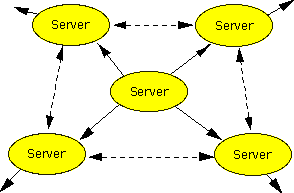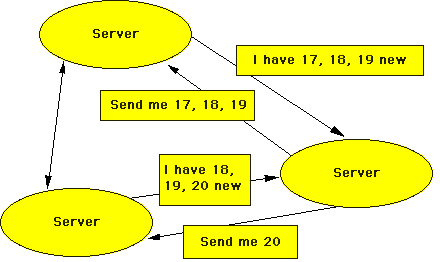|
Information about a user, such as how much this user has seen, is stored in the client.
The server need not even know which users are using it. There are many different
user-interface softwares for Usenet News, Some of them, of course, do not provide
all the available functions.
In addition, Usenet News provides an interesting functionality
which restricts communication to only those members of a newsgroup who work in the
same organization or live in the same area or country. This functionality, however,
is not used very much, and its existence is controversial, since it means that different
users will get different views of the same newsgroup.
Usenet news has a cancel command, which can delete messages
already sent out. Only the author of the cancelled message and the local newsserver
administrator is allowed to cancel a message. Since, however, it is very easy to
fake your identity, this command poses an obvious security risk, and the command
is known to have been used to cancel messages for political reasons. The command
is also used (not quite appropriate) by cancelbots, robots (= automatic programs)
which cancel obvious spams by identifying messages with the same content sent to
many disparate newsgroups. Usenet news also often has a Supersedes header field,
which refers from a new message to an old message. This header usually cancels the
old message.
Obsoletes in X.400 has some similarities to Supersedes in Usenet
News, and can also be used to get an effect similar to the cancel command, by obsoleting
a message with an empty message. However, cancel in Usenet News really deletes messages,
while obsoletes is information to the recipient UA, which need not cause deletion.
Many UA-s store both the new and the old version, so that the recipient can choose
to see the obsoleted version if he so wishes.
The most important restriction of Usenet News is that closed groups
are not well supported.
The Usenet News protocol is called network news transfer protocol
(NNTP) and is specified in RFC 977 [46]. The standard for the format of Usenet News
articles is specified in RFC 1036 [19].
The table below lists the most common NNTP commands:
|
| article [<Message-ID> | <Number>] |
Return text of designated article. If no parameter is given, the next article is
returned. The current article pointer is put at the fetched article. |
| body [<Message-ID>| <Number>] |
As article, but only returns body |
| group <newsgroup> |
Go to the designated newsgroup |
| head [<Message-ID> | <Number>] |
As article, but only returns head |
| help |
Lists available commands |
| ihave <messageID> |
Informs the server of an available article. The server can then ask for the article
or refuse it. |
| last |
Sets current article pointer to last message available, return the number and Message-ID. |
| list [active | newsgroups | distributions | schema] |
Returns a list of valid newsgroups in the format: group last first |
| newgroups <yymmdd hhmmss> ["GMT"] [<distributions>] |
List newgroups created since a certain datetime. "distributions" can be
e.g. alt to only get newsgroups in the alt category. |
| newnews <newsgroups> <yymmdd hhmmss> ["GMT"] [<distributions>] |
List Message-ID of articles posted to one or more newsgroups after a specific time.
newsgroups can be. e.g. net.*.unix to match more than one newsgroups. distributions
checks for articles which also has this other newsgroup as recipient. |
| next |
Current article pointer is advanced. Returns number and Message-ID of current article. |
| post |
Submit a new article from a client. |
| slave |
Tells the server that this is not a user client, it is a slave server. (May give
priority treatment.) |
| stat [<Message-ID> | <Number>] |
As article, but only returns Message-ID. Used to set the current article pointer. |
|
|
There is a problem with the newsgroups header in a message sent via e-mail.
Different systems use this header in two different ways:
- To indicate that this message has also been sent via Usenet news to the indicated
newsgroups.
- To indicate that this is a personal reply, sent only via e-mail, to a message
posted on the indicated newsgroups.
Because of this problem, it is better to use the Posted-To header in
e-mail to indicate that a message has also been sent to certain newsgroups, and e-mail
recipients should ignore any newsgroups heading in an e-mail message.
Traditionally, Usenet News has not been using the MIME standard for binary attachments
like images. Instead of BASE64, UUENCODING is often used in Usenet News to include
binary attachments, even if MIME is slowly gaining foothold also in Usenet News.
Because of message size restrictions, large attachments are often split into several
messages in Usenet News. This also occurs in e-mail, but is more frequent in Usenet
News, since some Usenet News servers try to save space by not accepting articles
above a certain size limit. Both MIME and Usenet News have methods of indicating
how a client can automatically combine parts into a complete message or attachments.
|

